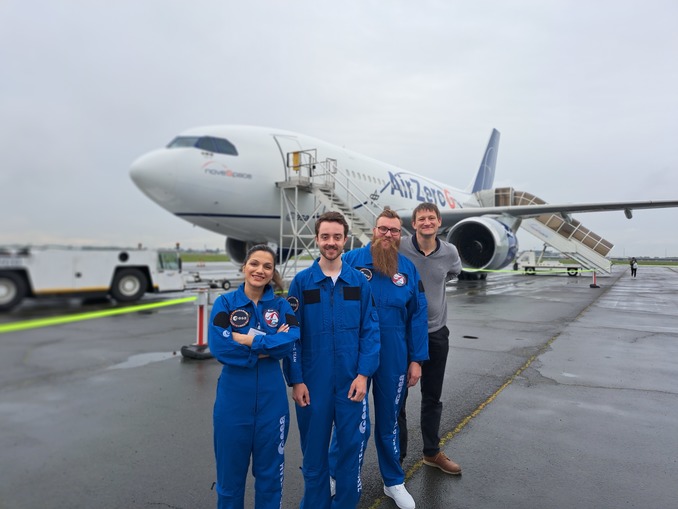Into weightlessness with the 3D printerResearch team at Aalen University researches components made from moon dust for astronauts

Prof. Dr. Miranda Fateri, Constantin Schuler, Sebastian Uhl and Prof. Dr. Matthias Haag from Aalen University shortly before the flight with the world's largest parabolic aircraft. © NOVESPACE | Thomas Villatte
July 20 is International Moon Day.
Who wouldn't want deeper insights into our universe? A team led by Prof. Dr. Miranda Fateri from the Faculty of Mechanical and Materials Engineering at Aalen University is laying the foundations for us to gain these even more efficiently and with fewer resources. The aim is to use the moon as a base in the future and to build infrastructure such as roads and "huts" there. To this end, the team recently carried out 3D printing experiments under lunar and Martian gravity. During a parabolic flight in France, they tested how stable components can be made from moon dust. Fateri is working with other partners such as the European Space Agency (ESA) to find out what challenges need to be overcome to make 3D printing work under the extreme conditions on the surface of the moon.
Together with her team, consisting of Prof. Dr. Matthias Haag, head of the Laboratory for Robotics and Virtual Systems at Aalen University, Sebastian Uhl and Constantin Schuler, both students of the Research Master Advanced Materials and Manufacturing, Fateri carried out 3D printing experiments with artificial moon dust on several parabolic flights in France. "When we went into zero gravity and the 3D printer started printing, I was so relieved," says the young scientist, who is delighted with the successful mission together with her cooperation partners. It was the 81st parabolic flight campaign for the ESA. The company Novespace, a subsidiary of the French space agency, made the current research in weightlessness possible - thanks to its Airbus A310 Zero G flight laboratory, the largest parabolic aircraft in the world.
Over three days, the team from Aalen University undertook flights lasting several hours. The researchers had the opportunity to print 3D structures 31 times per day under real lunar and Martian gravity conditions. These were not the first parabolic flights for Fateri. Apart from her research work, what fascinates her about weightlessness? "You weigh less, without having to diet," she smiles.
3D-printed components made from moon dust for astronauts
Prof. Dr. Miranda Fateri is one of the few women in Germany working on an ESA-funded research project into how 3D printing can be used to produce important spare parts for astronauts directly on the surface of the moon. Her research aims to lay the foundations for the most efficient and resource-saving exploration of the universe by making the moon usable through the construction of infrastructure, such as roads and living spaces. It would be practical to build the components and spare parts directly on the moon and use solar energy to produce the required building materials from moon dust, which is available there in large quantities but is very rare and expensive here on earth. This could reduce the expensive and time-consuming transportation of materials from Earth using rockets.
The research team is currently investigating whether the 3D-printed components are stable enough and whether the artificial material - a combination of moon dust and plastic, which is used for the test trials - is suitable. In view of the upcoming NASA moon mission "Artemis 2" in November 2024, during which humans will orbit the moon for the first time since 1972, the research group at Aalen University is excited to see what results they will be able to present to the public by then.
